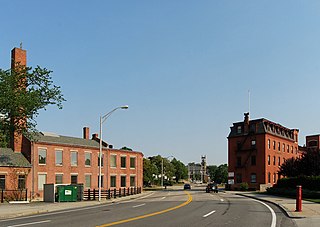
North Providence is a town in Providence County, Rhode Island, United States. The population was 32,078 at the 2010 census.

The First Baptist Church in America is the First Baptist Church of Providence, Rhode Island, also known as the First Baptist Meetinghouse. It is the oldest Baptist church congregation in the United States, founded in 1638 by Roger Williams in Providence, Rhode Island. The present church building was erected in 1774–75 and held its first meetings in May 1775. It is located at 75 North Main Street in Providence's College Hill neighborhood. It was designated as a National Historic Landmark in 1960.

Union Station describes two distinct defunct train stations in Providence, Rhode Island.

The Blackstone Canal was a waterway linking Worcester, Massachusetts, to Providence, Rhode Island through the Blackstone Valley via a series of locks and canals during the early 19th century.

The Slater Mill is a historic textile mill complex on the banks of the Blackstone River in Pawtucket, Rhode Island, modeled after cotton spinning mills first established in England. It is the first water-powered cotton spinning mill in North America to utilize the Arkwright system of cotton spinning as developed by Richard Arkwright.

The Eleazer Arnold House is a historic house built for Eleazer Arnold in about 1693, and located at 487 Great Road, Lincoln, Rhode Island in the Great Road Historic District. It is now a National Historic Landmark owned by Historic New England, and open to the public on weekends.

S. Stephen's Church is an historic Episcopal church located at 114 George Street in the College Hill neighborhood of Providence, Rhode Island. Located in the midst of the Brown University campus, it is an active parish in the Episcopal Diocese of Rhode Island, with a strong Anglo-Catholic identity.

This is a list of the National Register of Historic Places listings in Providence County, Rhode Island.

The College Hill Historic District is located on the East Side of Providence, Rhode Island, United States. It was designated a National Historic Landmark District on December 30, 1970. The College Hill local historic district, established in 1960, partially overlaps the national landmark district. Properties within the local historic district are regulated by the city's historic district zoning ordinance, and cannot be altered without approval from the Providence Historic District Commission.

The Great Road Historic District is a historic district in Lincoln, Rhode Island, commemorating a portion of Rhode Island's oldest highway, dating back to 1683. Great Road served as the main connection between Providence, Hartford and Worcester during colonial times. The district includes a 0.6-mile (0.97 km) section of the road, which winds along the Moshassuck River between a junction with Breakneck Hill Road and another with Front Street. Notable historic properties along this stretch of road include the National Historic Landmark Eleazer Arnold House, a stone-ender built in 1687, which is now a museum operated by Historic New England, the 1812 Moffett Mill, the Israel Arnold House, and Hearthside, the 1810 home of Stephen Smith, who established the adjacent Butteryfly Mill in 1811.

The Captain John Mawdsley House, located at 228 Spring Street, is one of the oldest houses in Newport, Rhode Island.

The Thomas Fenner House or the "Sam Joy Place" is a historic stone-ender house in Cranston, Rhode Island. It is one of the oldest surviving houses in Rhode Island. The house was built as a farmhouse around 1677 after King Philip's War by Captain Arthur Fenner for his son Major Thomas Fenner. The house was added to the National Register of Historic Places in 1990. It is privately owned and is not open to the public.

The Joseph Smith House is a historic house at 109 Smithfield Road in North Providence, Rhode Island, United States. It is a 2½-story wood frame house, six bays wide, with a shed-style addition to the rear giving it a saltbox appearance. The oldest portion of this house, built around 1705, is a classical Rhode Island stone-ender house, whose large chimney has since been completely enclosed in the structure. The lower levels of this chimney are believed to predate King Philip's War (1675–76), when the previous house was burned. The 1705 house was built by Joseph Smith, grandson of John Smith, one of Rhode Island's first settlers. It was greatly enlarged in 1762 by Daniel Jenckes, a judge from a prominent Rhode Island family, for his son, and was for many years in the hands of Jenckes' descendants. The house is the only known surviving stone-ender in North Providence.

The Whipple–Angell–Bennett House is an historic house at 157 Olney Avenue in North Providence, Rhode Island. It is a 1-1/2 story gambrel-roofed wood frame structure, four bays wide, with a series of additions extending it to the north and east. Built in 1766, it is one of only two surviving gambrel-roofed 18th-century houses in North Providence. Its additions exhibit the adaptive reuse of and changes in vernacular style in the 19th and early 20th centuries. The interior of the house has retained a great deal of integrity, with original woodwork, plasterwork, and door hardware.

The Joseph Haile House is an historic house in the College Hill neighborhood of Providence, Rhode Island. It is a 3-1/2 story brick structure, appearing taller than that due to its hillside location and raised basement. It is a well-preserved example of Federal styling, which underwent a careful restoration in the 1930s by George Warren Gardner, who filled the house with early American furniture. The Gardners bequested the property to Brown University, which uses it to house visiting dignitaries.

The Thomas F. Hoppin House is a historic house at 383 Benefit Street in the College Hill neighborhood of Providence, Rhode Island. The house was built c. 1853 to a design by Alpheus C. Morse, and is an elaborate local example of an Italianate palazzo-style residence. The Hoppins were well known for the social gatherings, and their house became known as the "house of a thousand candles".

Moshassuck Square is an industrial historic district in Providence, Rhode Island, lining the banks of the Blackstone Canal just north of the Rhode Island State House. It consists of the few surviving buildings of the once-extensive American Screw Company complex, which was largely developed between the 1840s and 1870s, and was a major fixture in the Providence landscape prior to its destruction by fire in 1971. The buildings are in an area bounded by Charles Street on the west, Stevens and Hewes Streets on the north, North Main Street to the east, and Mill Street to the south. Prominent among them are the Stillman White Foundry and Fletcher Manufacturing Company office building, which stand on opposite sides of Mill Street near its crossing of the canal. At 127 Charles Street stands a three-story brick building built c. 1900 as a retail and residential building. The only surviving elements of the Screw Company complex are located at North Main and Hewes Streets, and now house the Providence Center.

Olney Street–Alumni Avenue Historic District is a residential historic district in northeastern Providence, Rhode Island. Located just north of the Moses Brown School campus, this is an enclave of 53 tasteful yet conservative houses built between about 1880 and 1938. It includes houses along Olney Street and Alumni Avenue between Hope and Arlington Streets, and includes a few houses on adjacent streets. Most of these houses are uniformly set back from the street, even though there was no zoning requiring that at the time, and are of brick and/or wood construction. They are stylistically heterogeneous, with Queen Anne and the Colonial Revival predominating.

The Joseph and William Russell House is an historic house at 118 North Main Street in the College Hill area of Providence, Rhode Island. It is a 3-1/2 story brick structure, built in 1772. It has a main facade five bays wide, with a center entry sheltered by a segmented-arch portico with Corinthian pilasters. The interior decorations of this house were removed and are on display at the Brooklyn Museum.





















